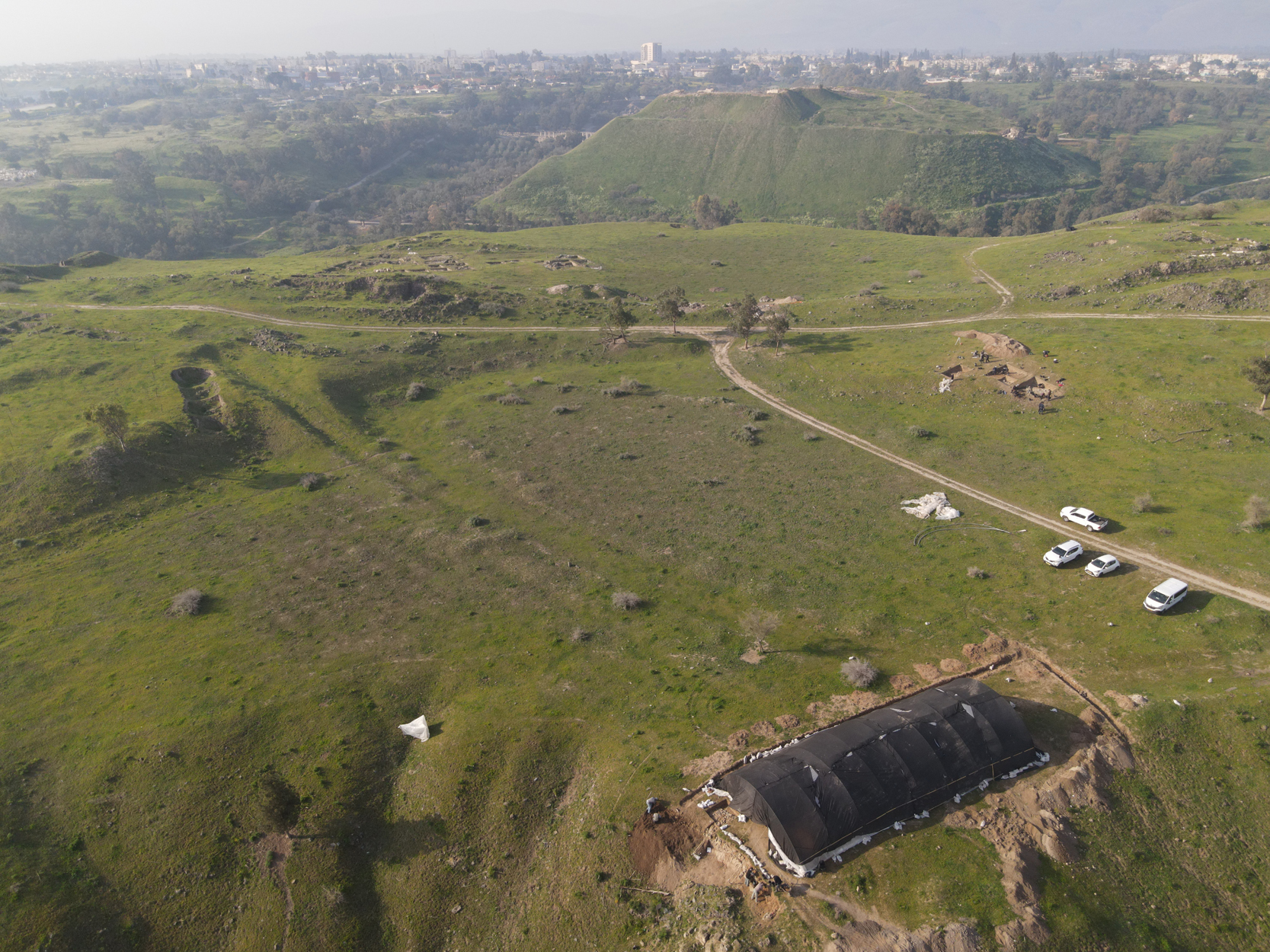The Coins from the 2023 Excavation Season of the German-Israeli Tell Iẓṭabba Excavation Project
Abstract:
This report catalogues and contextualizes the Hellenistic,
Roman, Byzantine and Islamic coin finds from the 2023 excavation
season of the German-Israeli Tell Iẓṭabba Excavation Project as
excavated in Areas E, F and G. All Hellenistic coins catalogued
below have been assigned to the Seleucid settlement at the site,
while many of the post-Hellenistic coins came from Area E, where
we have uncovered the Byzantine city wall. In total 44 coins are
catalogued: 18 Seleucid coins [two are unidentifiable]; four
Hellenistic civic coins; an isolated Hasmonean coin, an isolated
Roman Provincial coin, 12 Late Roman coins, three Byzantine
coins, three Islamic coins and additional two unidentified
coins. These coins supplement the coins published from previous
seasons (from Areas B, C and D) and further contributes to the
knowledge of the numismatic data of Tell
Iẓṭabba and to our
understanding of the overall settlement history at the site.
Keywords:
Coin finds, Seleucid coins, Roman coins, Byzantine coins,
Islamic coins, Tell Iẓṭabba, Nysa-Scythopolis, Beth Shean
Abstract: Dieser
Bericht katalogisiert und kontextualisiert die hellenistischen,
römischen, byzantinischen und islamischen Münzfunde der
Grabungssaison 2023 des German-Israeli Tell
Iẓṭabba Excavation
Project in den Areas E, F und G. Alle im Folgenden
katalogisierten hellenistischen Münzen werden der seleukidischen
Siedlung an diesem Ort zugeordnet. Viele der späteren Münzen
stammen aus Area E, in der die byzantinische Stadtmauer
ausgegraben wurde. Insgesamt wurden 44 Münzen katalogisiert (18
seleukidische Münzen [zwei sind nicht genau bestimmbar], vier
städtische hellenistische Münzen, eine hasmonäische Münze, eine
kaiserzeitliche Städteprägung, 12 spätrömische Münzen, drei
byzantinische Münzen, drei islamische Prägungen und noch zwei
unbestimmte Münzen). Obwohl die Anzahl an Münzen relativ gering
ist, ergänzen sie die in den vorangegangenen Jahren publizierten
Münzen (aus den Areas B, C und D) und tragen weiter zur Kenntnis
der Fundmünzen von Tell Iẓṭabba und zu unserem Verständnis der
Siedlungsgeschichte des Ortes bei.
Stichwörter:
Fundmünzen, seleukidische Münzen,
römische Münzen, byzantinische Münzen, islamische Münzen, Tell
Iẓṭabba, Nysa-Scythopolis, Beth Shean
During the 2023 season
of the German-Israeli Tell Iẓṭabba Excavation Project more than
200 coins were found (fig. 1). A considerable number of
these coins (over 150), however, came from the surface layer and
are not part of this catalogue and are to be published in a
different paper. In total 44 coins originate from the excavated
areas and they range in date from Antiochus III to the Seljuqs
representing over a thousand years of circulation.
The German-Israeli Tell
Iẓṭabba Excavation Project was initiated in 2019 with the
purpose of investigating the short-lived Seleucid settlement of
Nysa-Scythopolis/Beth Shean, located on Tell
Iẓṭabba (fig. 2)[1].
The final excavation report of the 2019–2020 excavations season
is currently in press and two coin reports were independently
published in the recent past[2].
Earlier excavations were undertaken by the Israel Antiquities
Authority (IAA) from 1991–1994 and have been published in part[3].
The coin finds from the IAA excavations were studied by Yoav
Farhi and still await their final publication[4].
Seleucid
Nysa-Scythopolis was founded in the time of Antiochus IV in the
160s BCE and destroyed by the Hasmonaean John Hyrcanus I in
spring/summer 107 BCE[5].
The late Hellenistic and Roman reoccupation of the settlement
took place in an adjacent area, to the south of the foot of the
biblical Tell Beth Shean, evidencing that the Seleucid site had
been left in ruins and only sparsely settled in later times. A
notable reoccupation of Tell Iẓṭabba took place during the
Byzantine period, when the northern flank of the city wall
crossed the entire mound from east to west and ecclesiastical
buildings were erected on Tell Iẓṭabba’s western parts[6].
The coin finds from our previous excavations mirror this
settlement history, with most coins belonging to the Hellenistic
period and some belonging to Late Antiquity, including also a
few Islamic coins.
The 2023 excavations
focused on three areas: one above and inside the Hellenistic
town walls (Area F); another that unearthed domestic structures
of the Seleucid settlement (Area G); and a third in which
sondages were taken of the Byzantine city wall against its inner
and outer facades (Area E)[7].
While Areas F and G were characterized by Seleucid architecture
with hardly any evidence of later reoccupation, in Area E
Byzantine architecture was uncovered, namely the city wall which
was apparently constructed and
repaired during the 5th and 6th centuries CE.
It comes as no surprise that 20 out of the 22 Hellenistic coins
were accordingly unearthed in Areas F and G. In the 2019 and
2020 seasons we found 37 coins in total, of which 29 were of
Hellenistic date. Among the previously found 22 Seleucid coins
14 were those of Alexander II Zabinas, of which ten constitute a
hoard. Even without the hoard, however, Zabinas coins had been
the most frequent in our previous excavation seasons, and the
2023 season also yielded a considerable number of coins minted
by this king (including stray finds), together with those of
other Seleucid kings, as specified in the Table below. It should
also be noted that another coin (SC
II, no. 2242, assigned now to
Nysa-Scythopolis) unearthed in 2023 (cat. no. 11, below),
provides additional evidence that these coins were indeed
locally minted[8].
The latest period Seleucid coin is that of Antiochus IX, either
from 114/113 BCE or 113/112 BCE (cat. no. 16). It should
be stressed that the Hasmonean coin of John Hyrcanus I, which
may well chronologically fit the site’s later days, was not
found in a Hellenistic layer proper but in a fill of the
Byzantine city wall in Area E (cat. no. 23). This coin
could therefore have arrived at the site before, during or after
its destruction in 107 BCE. It should be noted that only a few
Hasmonaean coins from Tell Iẓṭabba had been recorded in previous
excavations[9].
The four civic coins of Ptolemais (Ake) (cat. nos. 19–22)
fit a familiar pattern at the site and in the region in general,
according to which Hellenistic coins from the mint of Ptolemais
were widely circulating across the southern Levant.
Later period coins of
the 3rd and 4th centuries CE probably constitute those that had
remained in circulation during building operations in Byzantine
times, whether of the city walls or the monastic facilities that
occupied the western parts of Tell Iẓṭabba (East). A substantial
number of these late antique coins stem from Area F, and have
usually been found in top soil layers or very close to the
surface. Also, the Islamic coins were found close to surface
level underlining that these coins relate to the overall
settlement history of the site and not necessarily to spot
specific activities.
Seleucids
Total
18
Antiochus III (223–187
BCE)
3
Antiochus IV (175–164
BCE)
2 or 3
Demetrius I (162–150
BCE)
3 or 4
Antiochus VII (138–129
BCE)
1
Alexander II Zabinas (128–123
BCE)
3
Antiochus VIII (125–121
BCE)
2
Antiochus IX (116–96
BCE)
1
Seleucid unidentified
2
Civic
Ptolemais (Ake)
4
Hasmonean
John Hyrcanus I (135–104
BCE)
1
Roman Provincial
unidentifiable
1
Late Roman
Total
13
Constantius II
(337–361
CE)
4
Theodosius I
(379–395
CE)
3
Theodosius II
(408–450
CE)
2
Marcian
(450–457 CE)
1
unidentifiable
3
Byzantine
unidentifiable
4
Umayyad
1
Abbasid
1
Seljuq
1
Total
44
Catalogue of the
coins
Seleucids
Cat. No. 1 – Area G
L. 702; B7051/1 (fig.
3)
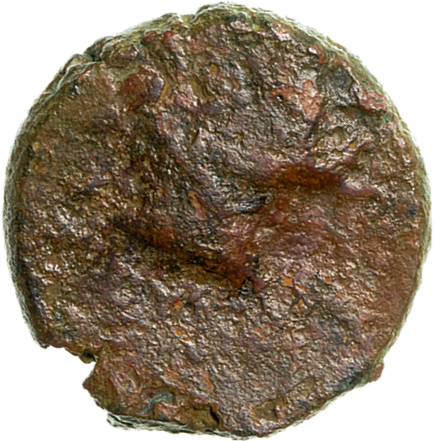
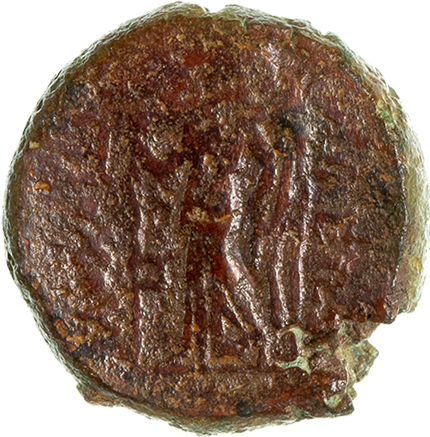
Uncertain mint 64, in southern Coele Syria, Antiochus III, from 198 BCE, thick, dumpy flan
Obv. Laureate head of
Apollo r., hair in krobylos with wavy lock falling behind ear,
another on back of neck, dotted circular border
Rev. ΒΑΣΙΛ[ΕΩΣ] on
r., [ΑN]TIOXOΥ on l., Nike advancing l., holding long palm in
extended r. hand, control mark (inner l., control mark
)
Æ denomination B, Ø 17
mm, 7.56 g; axis 12
Ref. cf.
SC I, 418, no. 1100
Cat. No. 2 – Area F
L. 608; B6095 (fig. 4)
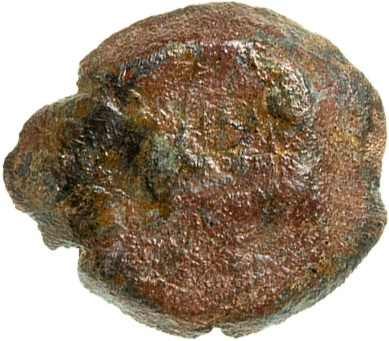
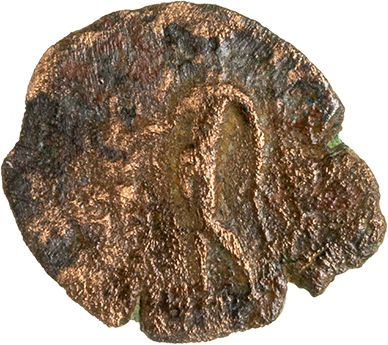
Antioch on the Orontes, Antiochus III, 223–187 BCE
Obv. Laureate head of
Apollo r., hair in krobylos behind, long wavy lock falling
behind ear, dotted circular border
Rev. [ΒΑΣΙΛΕΩΣ] on r.,
[ΑNTIOXOΥ] on l., Apollo standing l., testing arrow and resting
l. hand on grounded bow
Æ denomination C, Ø 16
mm, 2.41 g; axis 12
Ref.
SC I, 402, no. 1056
Cat. No. 3 – Area G
L. 703; B7004 (fig. 5)
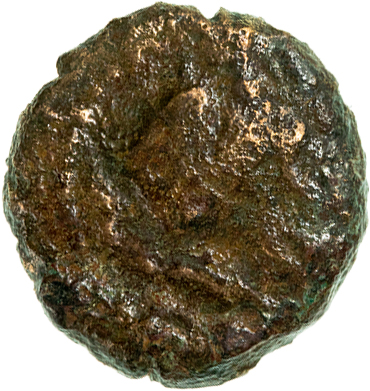
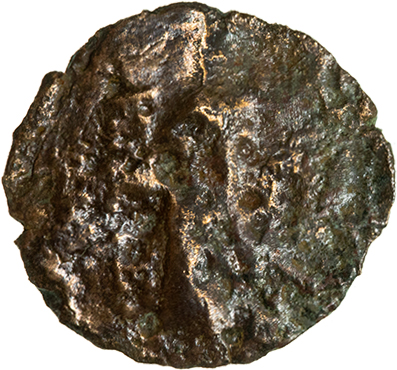
Antioch on the Orontes, Antiochus III, 223–187 BCE
Obv. Laureate head of
Apollo r., hair in krobylos behind, long wavy lock falling
behind ear, dotted circular border
Rev. [ΒΑΣΙΛΕΩΣ] on r.,
[ΑNTIOXOΥ] on l., Apollo standing l., testing arrow and resting
l. hand on grounded bow
Æ denomination C, Ø 16
mm, 2.30 g; axis 12
Ref.
SC I, 402, no. 1056
Cat. No. 4 – Area F
L. 622; B6139 (fig. 6)
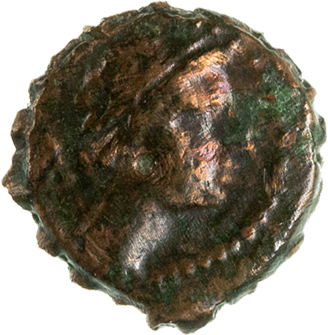
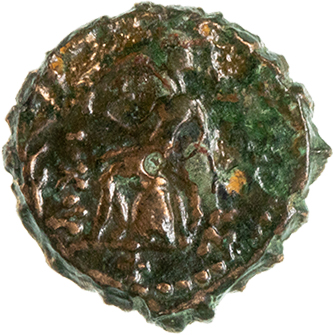
Ptolemais (Ake), Antiochus IV, 175–173/2 BCE, serrated edge, with central cavities
Obv. Laureate head of
Apollo r., control mark
Rev. [ΒΑΣΙΛΕ]ΩΣ on r.,
ΑNTIOXOΥ on l., Apollo seated l. on omphalos, testing arrow and
resting hand on grounded bow, often compound, symbol in outer l.
aphlaston, in ex., control mark +
Æ denomination D, Ø 14
mm, 2.00 g; axis 12
Ref.
SC II, 91, no. 1478.1
var.
Cat. No. 5 – Area F
L. 607; B6053 (fig. 7)
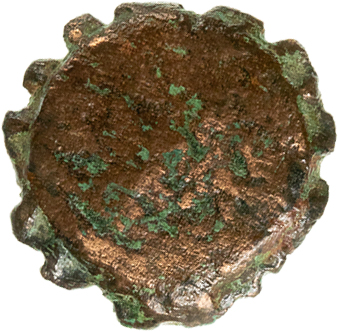
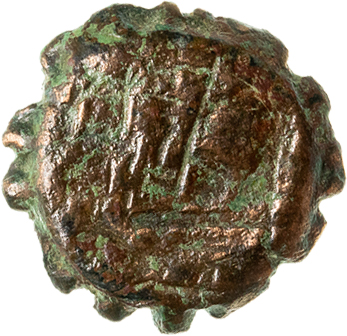
Ptolemais (Ake), Antiochus IV or Demetrius I, 175–150 BCE, serrated edge
Obv. Worn
Rev. Worn, obliterated
Æ denomination D, Ø 14
mm, 2.89 g; axis 12(?)
Ref. SC II, 91–92, nos.
1478–1479 or 181,
no. 1679
Cat. No. 6 – Area F
L. 608; B6062 (fig. 8)
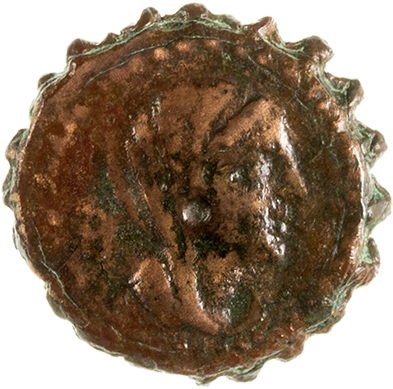
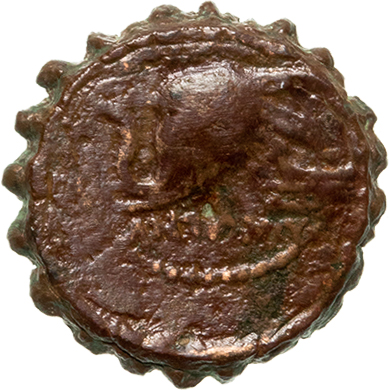
Ptolemais (Ake), Antiochus IV, 175–173/2 BCE, serrated edge, with central cavities
Obv. Veiled, diademed
bust of Laodice IV r., control mark behind head
Rev. [ΒΑΣΙΛΕΩΣ] above,
ΑNTIOXOΥ below, elephant head l., symbol on r., prow, dotted
circular border, control illegible
Æ denomination C, Ø 17
mm, 3.70 g; axis 12
Cat. No. 7 – Area F
L. 616; B6148 (fig. 9)
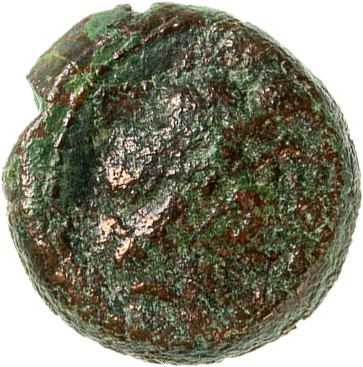
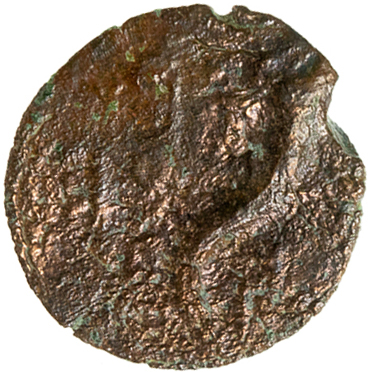
Seleucia on the Tigris, Demetrius I, 162–150 BCE(?)
Obv. Diademed head of
Demetrius I r., dotted circular border
Rev. [ΒΑΣΙΛΕΩΣ] on r.,
[ΔΗΜΗΤΡΙΟΥ] on l. [ΣΩΤΗΡΟΣ] in ex., cornucopia
Æ denomination C, Ø 15
mm, 2.96 g; axis 12
Ref. cf.
SC II, 188, no. 1704
Cat. No. 8 – Area G
L. 702; B7207 (fig. 10)
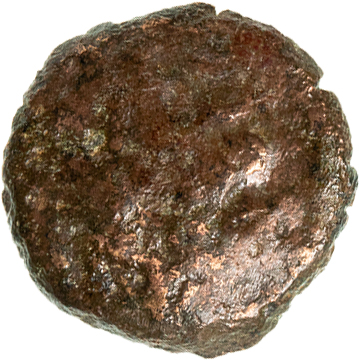
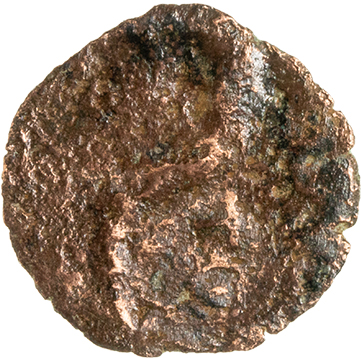
Seleucia on the Tigris, Demetrius I, 162–150 BCE(?)
Obv. Worn
Rev. [ΒΑΣΙΛΕΩΣ] on r.,
[ΔΗΜΗΤΡΙΟΥ] on l. [ΣΩΤΗΡΟΣ] in ex., cornucopia, in r. field
remnants of control mark(?)
Æ denomination C, Ø 15
mm, 1.89 g; axis 12
Ref. cf.
SC II, 188, no. 1704
[Comment: The attribution of nos. 7–8 to Seleucia on the Tigris is uncertain.]
Cat. No. 9
– Area G
L. 729; B7333 (fig. 11)
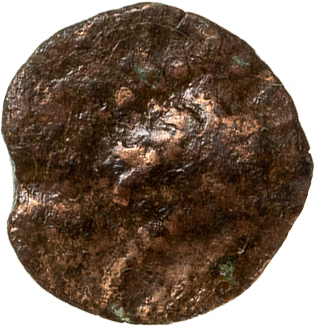
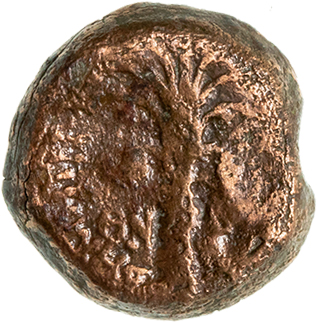
Tyre, Demetrius I, 154–153 BCE, slightly bevelled edge
Obv. Diademed head of
Demetrius I r., diadem ends falling straight behind, dotted
circular border
Rev. [ΒΑΣΙΛΕΩΣ]
(curving) on r., ΔΗΜΗΤΡΙΟΥ (curving) on l., palm tree, date
(across field) ΘΝ – Ρ (S.E. 159 = 154/153 BCE), dotted circular
border
Æ denomination D, Ø 13
mm, 2.18 g; axis 12
Ref.
SC II, 180, no. 1676.3;
Syon 2014, 128, table 5.23; cf. nos. 208‒233
Cat. No. 10 – Area G
L. 706; B7095 (fig. 12)
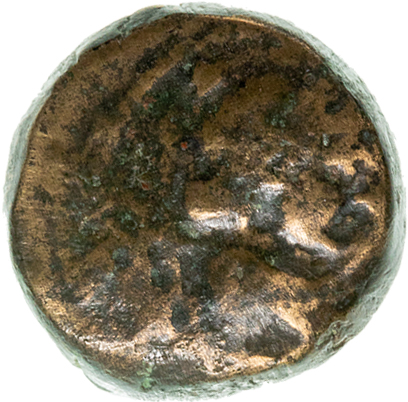
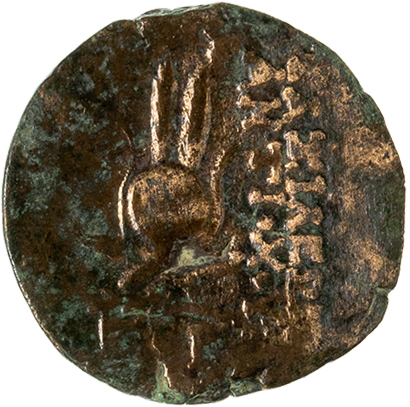
Antioch on the Orontes, Antiochus VII, 139/138 BCE; slightly bevelled edge
Obv. Bust of winged Eros
r., dotted circular border
Rev. ΒΑΣΙΛΕΩΣ
ΑNTIOXOΥ in two lines on r., [ΕΥΕΡΓΕΤΟΥ] on l., Isis headdress,
resting on two ears of grain with stems crossed, date in ex. ΔΟΡ
(S.E. 174 = 139/138 BCE)
Æ denomination B, Ø 15.5
mm, 6.14 g; axis 1
Cat. No. 11 – Area F
L. 622; B6149 (fig. 13)
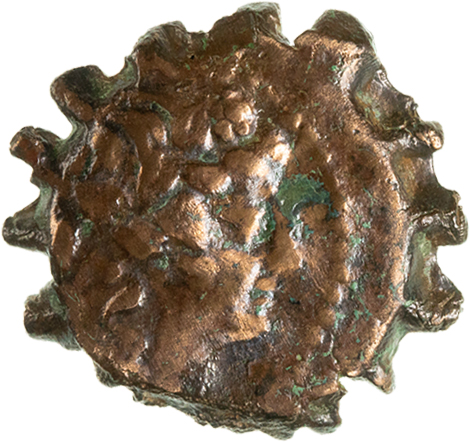
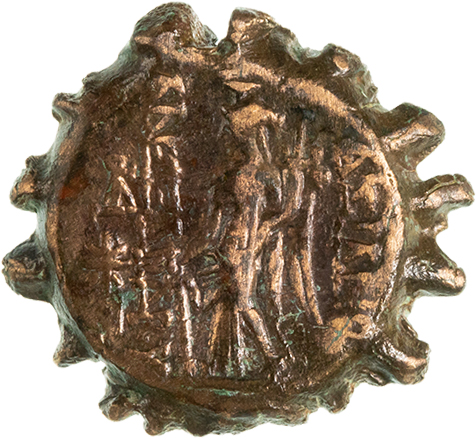
Nysa-Scythopolis, Alexander II Zabinas, 128–122 BCE, serrated edge
Obv. Head of young
Dionysus r., wreathed with ivy, dotted circular border
Rev. [Β]ΑΣΙΛΕΩΣ on r.,
ΑΛΕΞΑΝΔΡΟΥ on l., winged Tyche standing l., calathus on head,
holding ship’s tiller and cornucopia, control mark on outer l.
above
Æ denomination B or C, Ø
20 mm, 6.33 g; axis 1
[Comment: These serrated bronzes have been attributed by Yoav Farhi to the Nysa-Scythopolis mint[10].]
Cat. No. 12 – Area F
L. 606; B6079 (fig. 14)
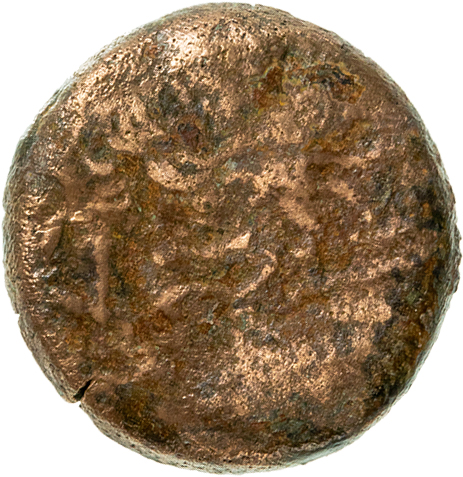
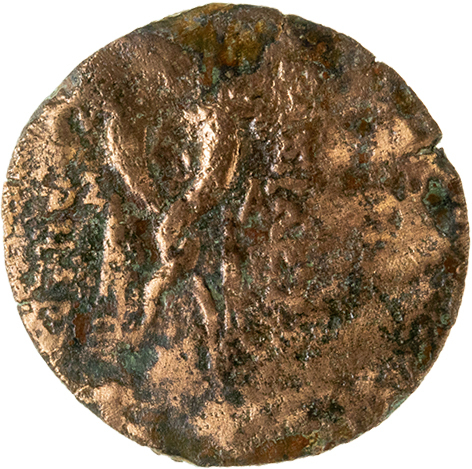
Antioch on the Orontes, Alexander II Zabinas, series 4, c. 125–122 BCE
Obv. Radiate, diademed
head of Alexander II Zabinas r., one diadem end waving up behind
neck, the other falling forward over shoulder, circular dotted
border
Rev. ΒΑΣΙΛΕΩ[Σ] on r.,
[ΑΛΕ]ΞΑΝΔΡ[ΟΥ] on l., two filleted cornucopiae, splayed and
intertwined, control marks Σ (inner l. above), Α (inner r.)
Æ denomination B, Ø 20
mm, 5.33 g; axis 3
Ref.
SC II, 456, no. 2235
Cat. No. 13 – Area F
L. 606; B6031 (fig. 15)
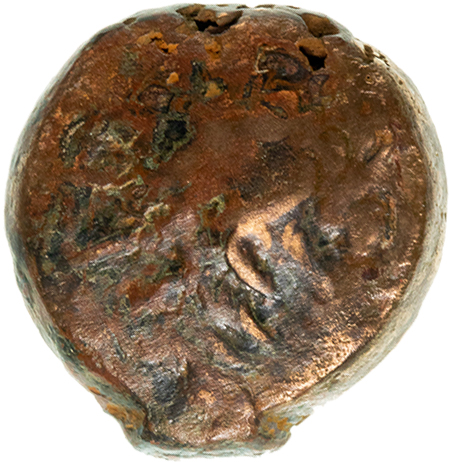
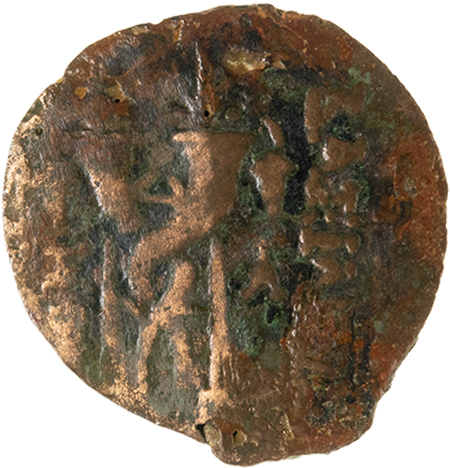
Antioch on the Orontes, Alexander II Zabinas, series 4, c. 125–122 BCE
Obv. Radiate, diademed
head of Alexander II Zabinas r., one diadem end waving up behind
neck, the other falling forward over shoulder, circular dotted
border
Rev. ΒΑΣΙΛΕΩΣ on r.,
[ΑΛΕΞΑΝΔΡΟΥ] on l., two filleted cornucopiae, splayed and
intertwined, control marks (inner l. above) Σ below grapevine(?)
(inner l. below), Α below grapevine(?)
Æ denomination B, Ø 20
mm, 5.86 g; axis 12
Ref. cf.
SC II, 456, no. 2235
Cat. No. 14 – Area G
L. 731; B7324 (fig. 16)
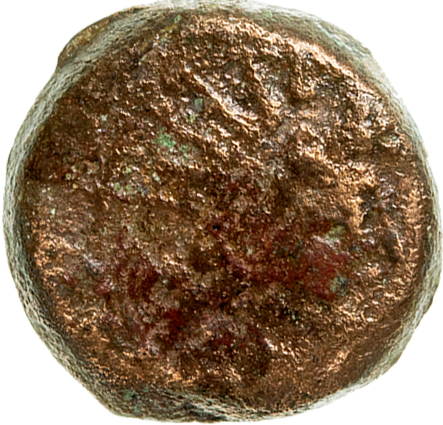
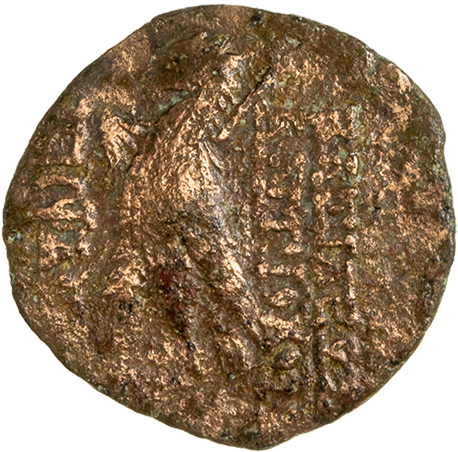
Antioch on the Orontes, Antiochus VIII, 121–113 BCE
Obv. Radiate, diademed
head of Antiochus VIII r., one diadem end waving up behind, the
other falling forward over shoulder, dotted circular border
Rev. ΒΑΣΙΛΕΩΣ ΑNTIOXOΥ
in two lines on r., ΕΠΙΦΑΝ[ΟΥΣ] on l., eagle standing l.,
sceptre under the wing
Æ denomination B, Ø 19
mm, 6.39 g; axis 12
Ref. SC II, 500 f.,
no. 2300 or
504,
no. 2307
Cat. No. 15 – Area G
L. 702; B7051/2 (fig. 17)
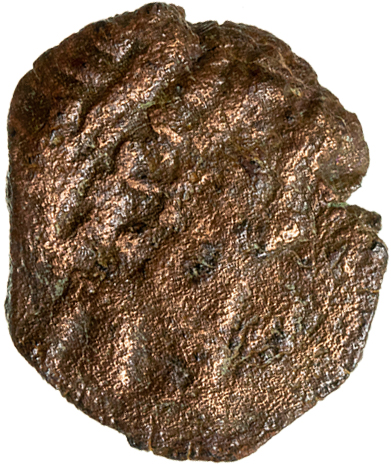
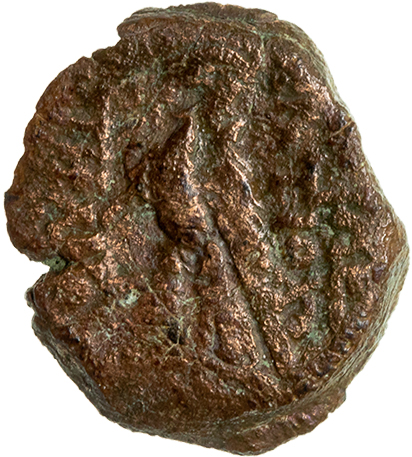
Antioch on the Orontes, Antiochus VIII, 121–113 BCE
Obv. Radiate, diademed
head of Antiochus VIII r., one diadem end waving up behind, the
other falling forward over shoulder, dotted (or, rarely, linear)
circular border
Rev. [ΒΑΣ]ΙΛΕ[ΩΣ]
ΑNTIOXOΥ in two lines on r., [Ε]ΠΙΦΑΝΟΥΣ on l., eagle standing
l., sceptre under far wing
Æ denomination B, Ø 20
mm, 4.06 g; axis 12
Ref. SC II, 500 f.,
no. 2300 or
504,
no. 2307
Cat. No. 16 – Area E
L. 520; B5014 (fig. 18)
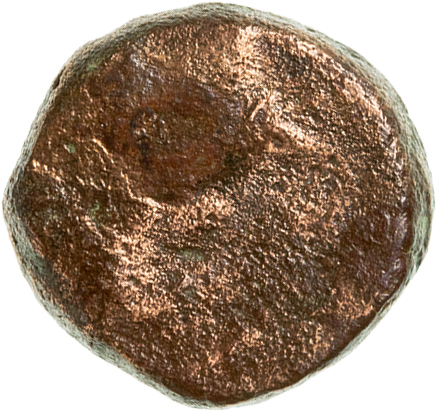
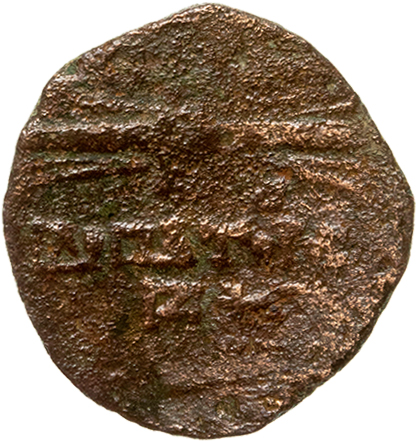
Antiochus IX Philopator,
Antioch on the Orontes, 114/113 BCE or 113/112 BCE;
bevelled flan
Obv. Worn
Rev. [ΒΑΣΙΛΕΩΣ ΑNTIOXOΥ]
in two lines to r., [Φ]ΙΛΟΠΑTOΡΟ[Σ] to l., winged thunderbolt
placed vertically, control mark ![]() and below cornucopia
and below cornucopia
Æ denomination B, Ø 18
mm, 5.33 g
Ref.
SC II, 534, no. 2364
Seleucid
unidentified
Cat. No. 17 – Area G
L. 716; B7950 (fig. 19)
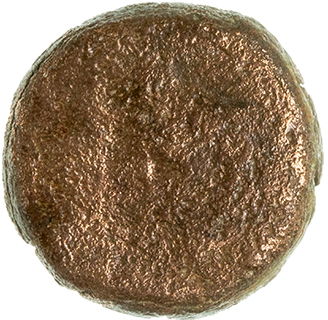
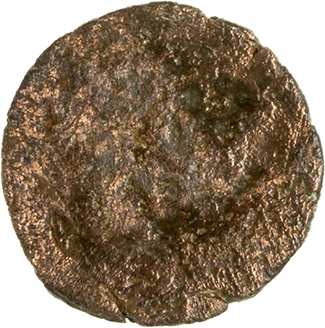
Unidentifiable Seleucid coin; slightly bevelled edge, central cavities
Æ, Ø 14
mm, 2.30 g
Cat. No. 18 – Area F
L. 627; B6180 (fig.
20)
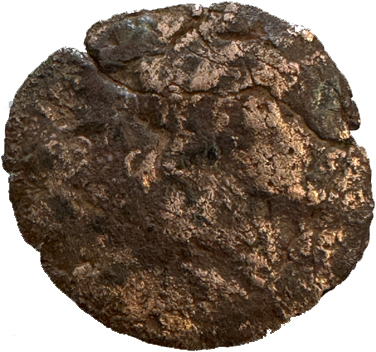
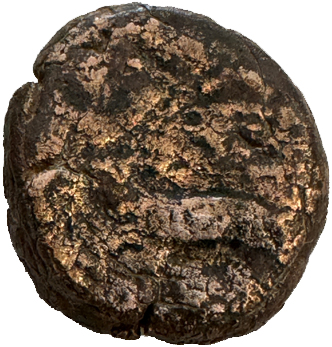
Unidentifiable Seleucid
coin; bevelled edge
Obv. Diademed head to r.
Rev. Worn
Æ, Ø 15 mm, 2.72 g
Civic (Seleucid
Era)
Cat. No. 19 – Area F
L. 604; B6020 (fig. 21)
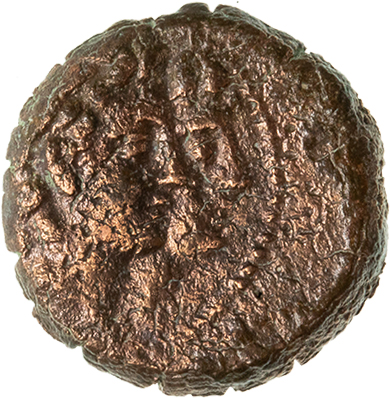
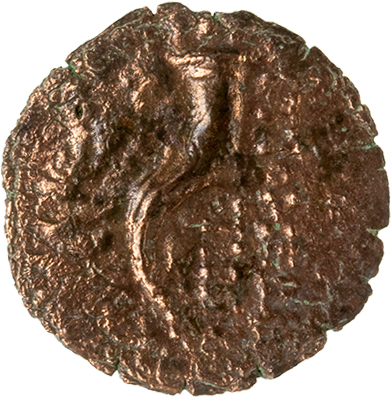
Ake, pre-colonial
autonomous civic coinage, 169–140 BCE; bevelled flan
Obv. Jugate busts of the
Dioscuri r.; circular dotted border
Rev. Cornucopia with
fruit; to r. and l. ΑΝΤΙΟΧΕΩΝ / ΤΩΝ / [ΕΝ / ΠΤΟΛΕΜΑΔΙ]; in l.
field, remnants of control mark/monogram
Æ, Ø 17 mm, 3.00 g; axis 12
Ref. cf. Kadman 1961, 18,
nos. 11–27; CHL, 8, nos. 68–74
Cat. No. 20 – Area G
L. 701; B7006-2 (fig. 22)
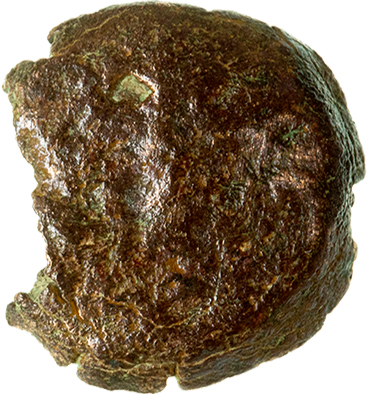

Broken
Ake, pre-colonial
autonomous civic coinage, 169–140 BCE; bevelled flan
Obv. Jugate busts of the
Dioscuri r.
Rev. Cornucopia with
fruit; to r. and l. [ΑΝΤΙΟΧΕΩΝ / ΤΩΝ / ΕΝ / ΠΤΟΛΕΜΑΔΙ]
Æ, Ø 17 mm, 3.05 g; axis 12
Ref. cf. Kadman 1961, 18,
nos. 11–27; CHL, 8, nos. 68–74
Cat. No. 21 – Area F
L. 617; B6147 (fig. 23)
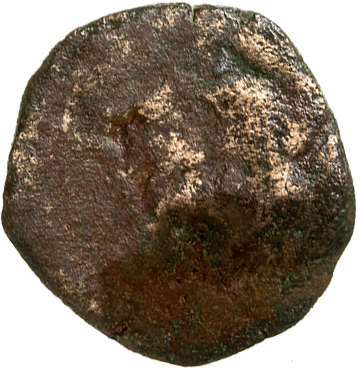
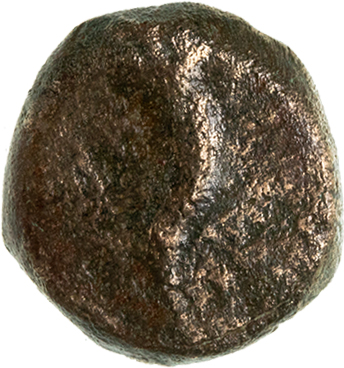
Ake, pre-colonial
autonomous civic coinage, 169–140 BCE; bevelled flan
Obv. Jugate busts of the
Dioscuri r.
Rev. Cornucopia with
fruit; to r. and l. [ΑΝΤΙΟΧΕΩΝ / ΤΩΝ / ΕΝ / ΠΤΟΛΕΜΑΔΙ]
Æ, Ø 17 mm, 3.27 g; axis 12
Ref. cf. Kadman 1961, 18,
nos. 11–27; CHL, 8, nos. 68–74
Cat. No. 22 – Area F
L. 620; B6275 (fig. 24)
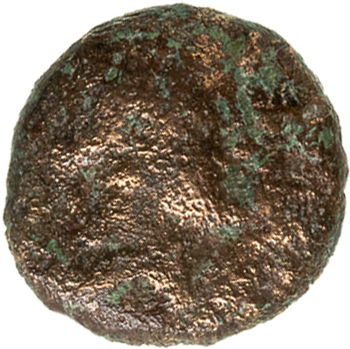
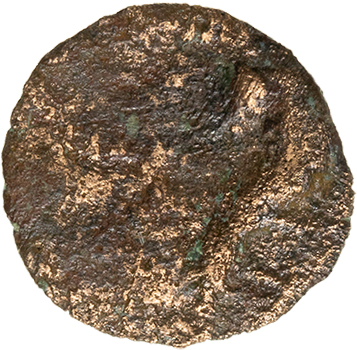
Ake, pre-colonial
autonomous civic coinage, 169–140 BCE; bevelled flan
Obv. Jugate busts of the
Dioscuri r.
Rev. Cornucopia with
fruit; to r. and l. [ΑΝΤΙΟΧΕΩΝ / ΤΩΝ / ΕΝ / ΠΤΟΛΕΜΑΔΙ]
Æ, Ø 17 mm, 2.13 g; axis 12
Ref. cf. Kadman 1961, 18,
nos. 11–27; CHL, 8, nos. 68–74
Hasmoneans
Cat. No. 23 – Area E
L. 537; B5051 (fig. 25)
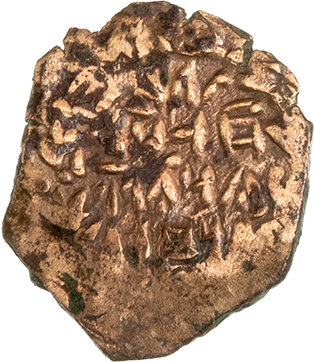
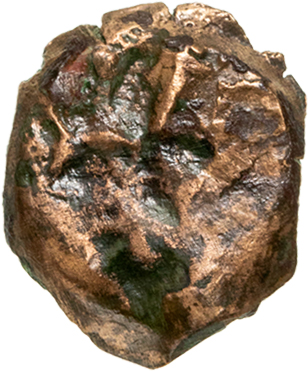
John Hyrcanus I, 135–104 BCE
Obv. YHW /
ḤNNHK /
HNHGDL / WḤBR / [HYDYM] (in paleo Hebrew, »Yehoḥanan the High
Priest and Council of the Jews«), surrounded by a wreath
Rev. Remnants of double
cornucopiae with a pomegranate between the horns
Æ, Ø 16 mm, 1.49 g; axis
12
Ref. cf. TJC (Group
D); CHL, 244, nos.
68–80
Roman Provincial
Cat. No. 24 – Area F
L. 642; B6321 (fig. 26)
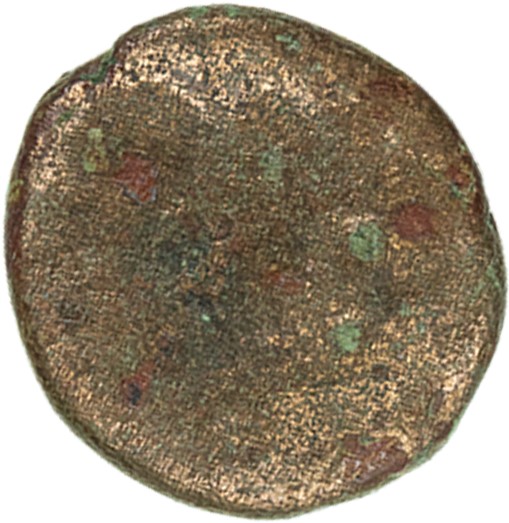

Unidentifiable Roman Provincial coin, 2nd–early 3rd century CE
Obv. Worn, bust of
emperor r.
Rev.
Worn
Æ, Ø 22.5 mm, 8.02 g;
axis -
Late Roman
Cat. No. 25 – Area F
L. 602; B6004 (fig. 27)
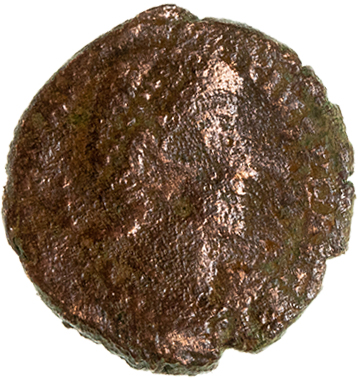
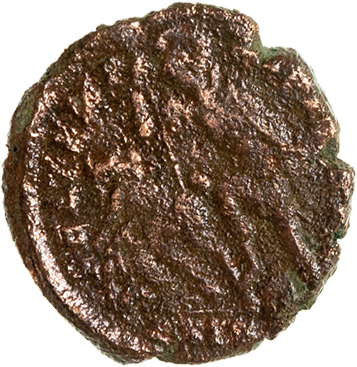
Constantius II, mint illegible, 350–361 CE
Obv.
[D N CON]STAN-TIVS P F AVG, draped and
cuirassed bust of Constantius
II r., pearl-diademed
Rev. FEL TEMP –
[REPARATIO] // SM [ ], soldier, helmeted,
draped, cuirassed, advancing l., spearing fallen horseman with
r. hand and wearing shield on l. arm; shield on ground to r.;
horseman is bareheaded, facing soldier, raising l. hand
Æ denomination AE3, Ø 16
mm, 2.16 g; axis 11
Ref. cf. RIC VIII
Cyzicus 104
Cat. No. 26 – Area F
L. 602; B6055 (fig. 28)
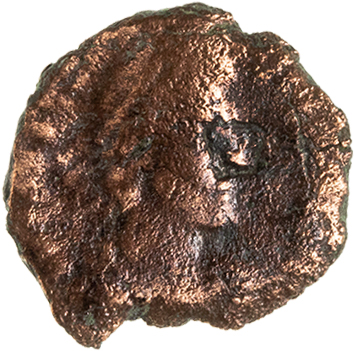
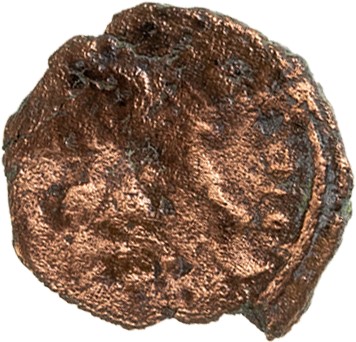
Constantius II, mint illegible, 350–361 CE
Obv.
D N CONS[TAN-TIVS P F AVG], draped and
cuirassed bust of Constantius II r., pearl-diademed
Rev. [FEL TEMP –
REPARAT]IO // [ ], soldier, helmeted, draped,
cuirassed, advancing l., spearing fallen horseman with r. hand
and wearing shield on l. arm; shield on ground to r.; horseman
is bareheaded, facing soldier, raising l. hand
Æ denomination AE3, Ø
16.5 mm, 1.63 g; axis 12
Ref. cf. RIC VIII
Cyzicus 104
Cat. No. 27 – Area F
L. 602; B6056 (fig.
29)
Broken
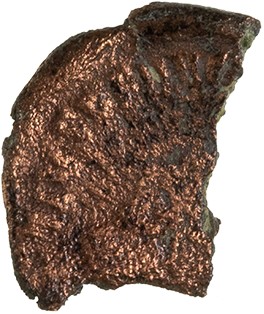
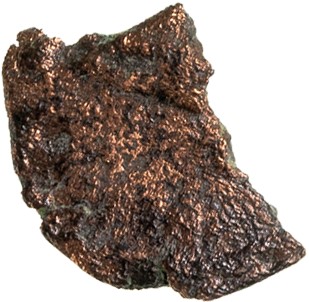
Constantius II, mint illegible, 355–361 CE
Obv.
[D N CONSTAN]–TIVS P F AVG, draped and
cuirassed bust of Constantius II r., pearl-diademed
Rev. [SPES REI–PVBLICA],
Constantius II, helmeted, draped, cuirassed, standing l.,
holding globe in r. hand and spear in l. hand
Æ denomination AE3, Ø 15
mm, 1.63 g; axis 6
Ref. cf. RIC VIII
Aquileia 235
Cat. No. 28 – Area E
L. 521; B5016 (fig. 30)
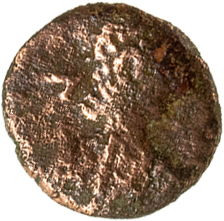
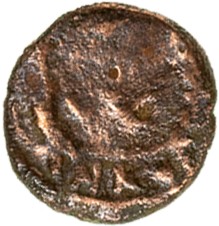
Under Theodosius I, Cyzicus, 378–383 CE
Obv.
Legend illegible, draped and cuirassed bust
of emperor r., pearl-diademed
Rev. [VOT/X/MVLT]/XX //
SMKA, legend in wreath
Æ denomination AE4, Ø
9.5 mm, 0.49 g; axis 7
Ref. cf. RIC IX Cyzicus
21A–D
Cat. No. 29 – Area F
L. 608; B6057 (fig. 31)
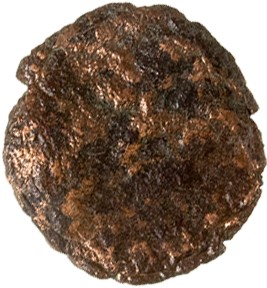
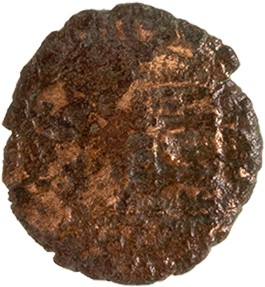
Magnus Maximus or Flavius Victor, mint illegible, 383–388 CE
Obv.
[D N ] P F AVG, draped and
cuirassed bust of Magnus Maximus or Flavius Victor r., diademed
Rev. [SPES ROMANO]RVM //
[S]MT[ ], Camp-gate with star between its
two turrets
Æ denomination AE4, Ø 12
mm, 0.69 g; axis 12
Ref. cf. RIC IX Treveri
87A–C
Cat. No. 30 – Area F
L. 638; B6304 (fig. 32)
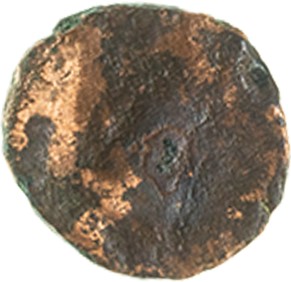
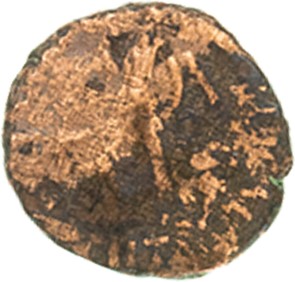
Theodosius I, Antioch on the Orontes, 383–392 CE
Obv.
[D N THEODO-SI]VS [P F AVG], draped and
cuirassed bust of Theodosius I r., rosette-diademed
Rev. [SALVS
REI-PV]BLICAE // [A]NTA, Victory advancing l., holding trophy on
shoulder with r. hand, and dragging captive with l. hand, in l.
field Chi-Rho
Æ denomination AE4, Ø
12.5 mm, 1.19 g; axis 5
Ref.
RIC IX Antioch 67C.1
Cat. No. 31 – Area E
L. 521; B5017 (fig. 33)
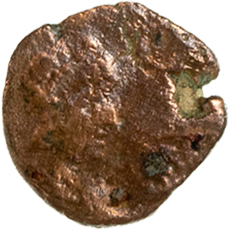
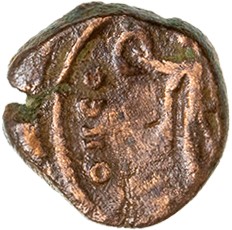
Theodosius II, mint illegible, 425–435 CE
Obv.
[D N THEODOSIVS P F AVG], draped and
cuirassed bust of Theodosius II r., pearl-diademed
Rev. CONCO-[RDIA AVG],
Victory, winged, draped, advancing forward, holding wreath in
both hands
Æ denomination AE4, Ø 10
mm, 0.73 g; axis 12
Ref. cf. RIC X
Theodosius II (East) 430–439
Cat. No. 32 – Area F
L. 602; B6054 (fig. 34)
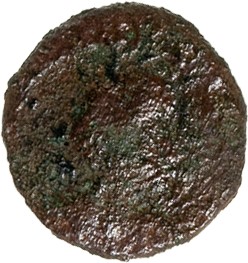
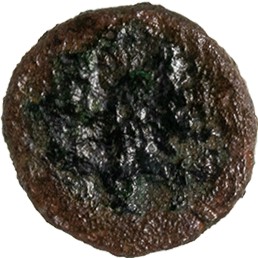
Theodosius II, Nicomedia or Constantinople, 445–450 CE
Obv.
[D N THEO]DOSIVS [P F AVG], draped and
cuirassed bust of Theodosius II r., pearl-diademed
Rev. Monogram of
Theodosius II within a wreath
Æ denomination AE3–4, Ø
11 mm, 0.67 g; axis 5
Ref. cf. RIC X
Theodosius II (East) 462–465
Cat. No. 33 – Area F
L. 605; B6025 (fig. 35)
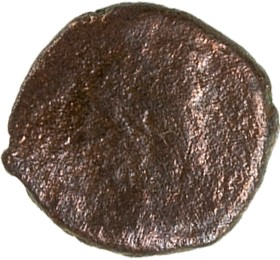
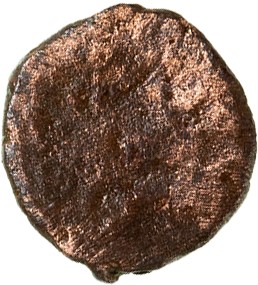
Marcian, mint illegible, 450–457 CE
Obv. [D N MARCIANVS P F
AVG], draped and cuirassed bust of Marcian r., pearl-diademed
Rev. Monogram of Marcian
within a wreath
Æ denomination AE4, Ø 12
mm, 1.09 g; axis 10
Ref. cf. RIC X Marcian
535–570
Cat. No. 34 – Area F
L. 608; B6063
Unidentifiable Late Roman coin, 4th–5th century CE
Obv.
Legend illegible, draped and cuirassed bust
of emperor r., diademed
Rev. Legend illegible,
Victory, winged, draped, advancing l., holding wreath or
dragging captive
Æ denomination AE4, Ø
10.5 mm, 0.69 g; axis 6
Cat. No. 35 – Area F
L. 601; B6005
Broken
Unidentifiable Late Roman, second half 4th century CE
Obv.
Worn, draped bust of emperor r., diademed
Rev. Worn
Æ denomination AE3, Ø 16
mm, 1.09 g; axis -
Cat. No. 36 – Area E
L. 529; B5034
Unidentifiable Late
Roman coin, second half 5th century CE
Obv.
Worn
Rev. Monogram
Æ denomination AE4, Ø 9
mm, 0.86 g; axis -
Byzantine
Cat. No. 37 – Area F
L. 604; B6028
Unidentifiable Byzantine minimus, late 5th–6th century CE
Obv. Worn
Rev.
Worn
Æ, Ø 7.5x10 mm, 1.11 g;
axis -
Cat. No. 38 – Area F
L. 625; B6175
Unidentifiable Byzantine minimus, late 5th–6th century CE
Obv. Worn
Rev.
Worn
Æ, Ø 11 mm, 1.72 g; axis
-
Cat. No. 39 – Area F
L. 624; B6201
Unidentifiable Byzantine minimus, late 5th–6th century CE
Obv. Worn
Rev.
Worn
Æ, Ø 7 mm, 0.56 g; axis
-
Umayyad
Cat. No. 40 – Area F
L. 605; B6048 (fig. 36)
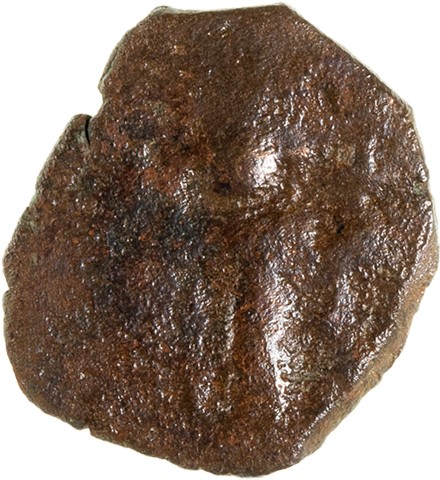
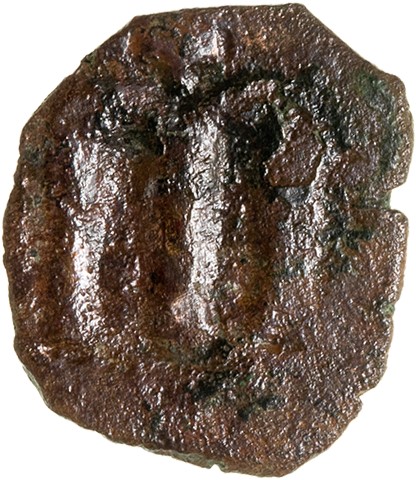
Pre-reform Arab-byzantine fals, 692–694 CE
Obv. Legend illegible,
Constans II standing frontal, holding cross-staff in r.,
cross-globe in l. hand
Rev.
Legend illegible, M, above cross
Æ fals, Ø 17x20 mm, 3.15 g; axis 11
Ref. cf. SNAT Iva, nos.
508-512; for the dating cf. Bates 2012
Abbasid
Cat. No. 41 – Area E
L. 520; B5013
Cut
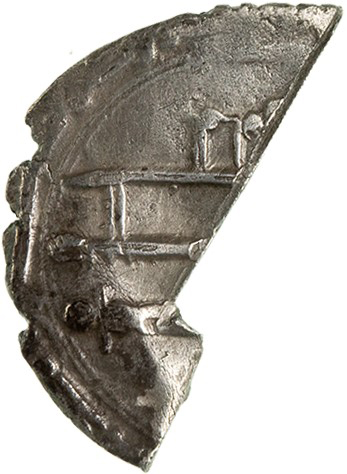
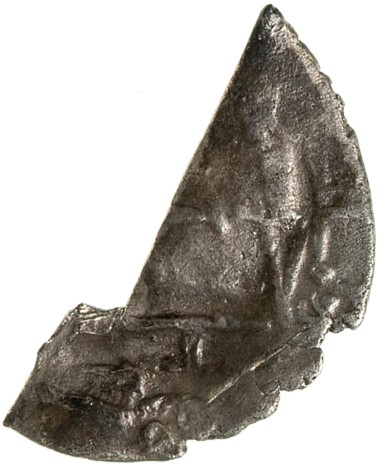
Al-Ma’mun (813‒833 CE), 208 AH (= 823 CE)
Silver dirham,
Ø 21.5 mm, 1.14 g; axis 12
Ref. cf. Savage 1999,
178, no. 1458
Seljuk
Cat. No. 42 – Area F
L. 600; B6185

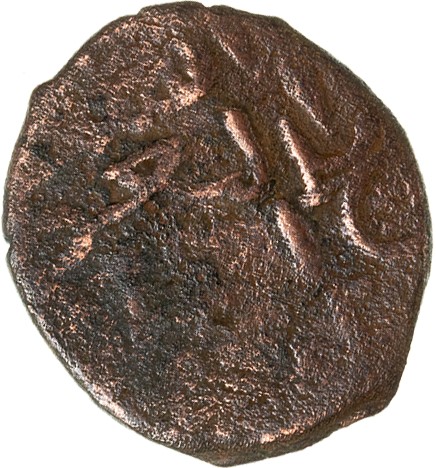
Qilij Arslan II (11/55‒1192
CE)
Obv. Upright horseman
with lance and arch inclined upward, charging to r.
Rev. Legend (title of
the sultan, with a few legible letters in the first two lines)
Æ, fals, Ø 20 mm, 3.19 g; axis 12
Ref. cf. Broome 2011,
46, no. 21B[11]
Unidentifiable
Cat. No. 43 – Area F
L. 601; B6006
Broken
Obv. Worn
Rev. Worn
Æ, Ø 12 mm, 0.82 g; axis
-
Cat. No. 44 – Area F
L. 606; B6071
Broken
Obv. Worn
Rev. Worn
Æ, Ø 12 mm, 0.60 g; axis
-
[1] Ebeling
et al. 2020; Ebeling et al. 2021; Edrey et al. 2022;
Edrey et al. 2023.
[2] Lichtenberger – Tal
2024. Previous coin reports: Lichtenberger – Tal 2020;
Lichtenberger – Tal 2021. Cf. also
Shamir – Lichtenberger – Tal 2021.
[3] Mazor
– Atrash – Finkielsztejn 2018 (with additional
bibliography on previous excavations).
[4] Farhi Forthcoming.
[5] Lichtenberger et al.
2022.
[6] On
Late Antiquity in Beth Shean see Tsafrir – Foerster
1997.
[7] Edrey et
al. 2023.
[8] Farhi
2022.
[9] Farhi
Forthcoming.
[10]
Farhi 2022.
[11] We
are indebted to R. Kool for providing this reference.
